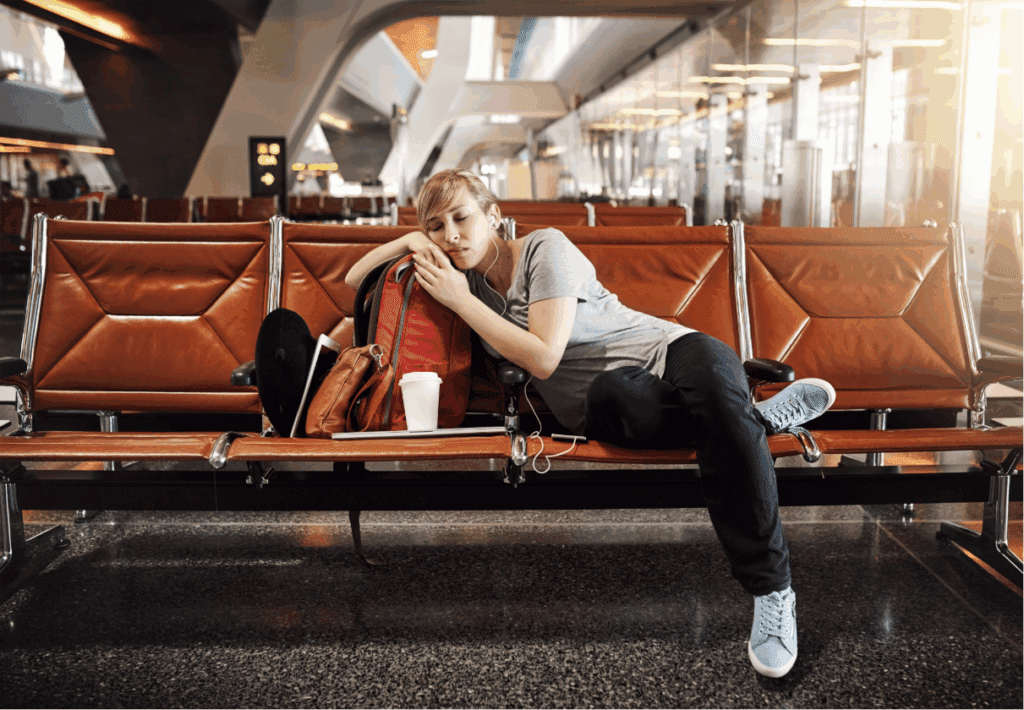
Jet lag: practical guide to realigning the biological clock with light (and a little science)
Jet-lag is not "travel fatigue": it is a circadian misalignment. After an intercontinental flight, the biological clock (which regulates sleep, hunger, hormones, energy) continues to run on the departure time zone while the external environment has changed. Hence nighttime insomnia, daytime sleepiness, decreased concentration, irritability and digestive disorders. Health authorities describe it as a real rapid spindle change sleep disorder, with symptoms that go beyond simply sleeping badly. CDC
Good news: the body fits. On average, the internal clock can move about 1-2 hours per day, but targeted strategies are needed to accelerate alignment and reduce symptoms (especially after crossings of many time zones). Patient
Why natural light is the most powerful lever
La light is the strongest synchronizer (zeitgeber) of the circadian rhythm. Exposure to the morning light tends to anticipate phase (will make you sleepy earlier the next night), while bright light late in the evening tends to delay it (will make you fall asleep later). This depends on the so-called phase response curve (PRC) to light, documented in controlled studies: depending on the time of day, the same light moves the clock forward or backward. PubMed+2physoc.onlinelibrary.wiley.com+2
What it means in practice
-
You arrive from the west and "gain" time: light in the late afternoon o early evening helps delay the clock; avoids the early morning light that would anticipate it.
-
You arrive from the east and "lose" time: search morning light early to anticipate the clock; limits bright light in the evening.
-
If the weather doesn't help, use the brightest possible ambient light or, in selected cases, a lamp from bright light for short sessions, adhering to the schedules above (a useful tool but to be used knowledgeably). Guidelines for travelers reiterate the usefulness of "being outdoors in well-lit areas" during the day to aid adaptation. wwwnc.cdc.gov
Note: On eastbound trips, the advance is usually more "difficult" than the westbound delay; therefore, exposure times matter even more. PMC
Avoiding artificial light in the evening: why it really matters
The "cold" blue-rich artificial light in the evening hours suppresses melatonin, delay the clock and gets worse sleep quality. In a controlled study, reading about a e-reader the evening has delayed the circadian phase, reduced evening sleepiness and worsened morning alertness compared with reading a paper book. PNAS+1
Evening operational lines
-
From 2-3 hours Before you go to bed: dimmera the house lights and prefer warm shades.
-
Screens: reduce use, activate "night" filters, and keep low luminance.
- Glasses blue-blocker: good allies, As soon as it gets dark use the red lenses, first the yellow ones.
Melatonin: effective, but the timing is all
La melatonin is a tool with good evidence for prevent or reduce jet-lag, especially with large spindle shifts. Its effectiveness depends on thehiring hours: taken close to the "target" sleep time at the destination, it helps align the clock; administered at different times can even move it in the opposite direction (as with light, there is a PRC of melatonin). PubMed+3Cochrane Library+3PMC+3
In practice
-
Travels with >5 spindlescurrency 0.5-3 mg shortly before Of the local target-bedtime for a few days.
-
It is not for everyone: interactions and any contraindications require medical advice, especially if you are pregnant/lactating or taking interfering medications. (General clinical indications and warnings also appear in the dissemination materials of major health care institutions.) Mayo Clinic
Exercise: a useful secondary "zeitgeber"
L'physical activity can shift (slightly) the clock, with direction dependent on the time: exercise morning/early afternoon tends to anticipate the phase; exercise evening tends to delay it. It is a more modest Than light, but useful as reinforcement. PMC+1
Caffeine: when it helps and when it hinders
Useful for vigilance in the early days, but goes timed. In a controlled study, 400 mg of caffeine intake up to 6 hours before going to bed have reduced sleep duration and worsened sleep parameters. Rule of thumb: avoid caffeine from the early afternoon onward into the new time zone (or at least in the 6-8 hours before sleep). PubMed+1
Meal times: a signal for peripheral "clocks"
La timing of meals does not command the "master clock" in the brain like light, but synchronize peripheral rhythms (liver, adipose tissue, glucose metabolism) and can help overall adaptation. Lab, delay 5 hours mealtimes shifted metabolic circadian markers measurably. Prudent strategy: align main meals at local times as soon as you arrive. PubMed+1
Operational plan: before, during and after the flight
1) Before the trip (2-3 days)
-
Push Gradually sleep and meal times toward the arrival time zone (30-60 minutes per day).
-
Prepare a light plan: if you go east, program morning light and avoid evening; if you go west, the opposite.
-
Reduce alcohol and caffeine excesses.
2) In flight
-
Hydrate And get up every 1 to 2 hours.
-
Use mask/caps, and if you have to sleep at "local" times, shielded from the light.
-
Keep the light meals.
3) Upon arrival (days 1-3)
-
Targeted natural light As per the strategy above; if there is no sun, maximize available daylight and ambient lighting. Official recommendations indicate to stay in well-lit areas during the day To speed up adaptation. wwwnc.cdc.gov
-
Evening in low lights, reduced screens or filtered; sleep and meal times immediately aligned at the venue.
-
Currency melatonin near local bedtime in the first few days if symptoms are marked (after medical advice). Cochrane Library
What to expect
Recovery times vary from person to person, from themagnitude of the shift and the direction of flight. On average, adaptation proceeds at 1-2 hours per day; with light-based strategies (and, if necessary, melatonin), you can shorten significantly the duration of symptoms and return to full efficiency sooner. Patient
IN PRACTICE.
The golden rules for managing jet lag
1. Morning advances, evening delays
All sunlight is not equal: exposing yourself to the sun. in the early morning hours sends the brain the signal that "the day has begun," leading the internal clock to anticipate its phase. Result: you will get sleepy a little earlier the next evening. In contrast, exposure to bright light in the late evening does the opposite, i.e. delay the biological clock and shifts sleep time forward.
That's why those traveling to east must seek morning light and avoid the evening one, while those flying to west will do the reverse: more light in the late afternoon and less morning exposure.
2. Screens and evening LEDs slow adaptation
In the evening, the body should increase the production of melatonin, the hormone that promotes sleep. But the blue light from tablets, smartphones and cold bulbs tricks the brain into stopping producing it. Result: you fall asleep later and worsen jet lag.
Simple solutions:
-
lowers the brightness Of the devices;
-
use night mode With warm tones;
-
Minimize the use of screens in the two hours before bedtime.
If you travel often or are particularly sensitive, goggles with blue-light filters can also be a useful aid, though not a substitute for good light hygiene practices.
3. Melatonin: it works, but only if timed correctly
Melatonin is one of the most studied tools and has been shown to be effective in the reduce the symptoms of jet lag, but it is not a "sleep pill." Its main function is to shift the circadian rhythm in the desired direction, and this depends on the exact moment In which it is hired.
-
If you take it too soon in the day, you risk "anticipating" sleep in an undesirable way.
-
If you take it too late, you may further delay the internal clock.
That's why research suggests taking it About half an hour to an hour before the time you want to go to sleep in the new time zone. For example: if you are flying to New York and want to adjust to local time, take melatonin just before bedtime at New York time, not the time in your country of departure.
It is also important to don't overdose: Low amounts (0.5-1 mg) appear to be as effective as higher dosages and reduce the risk of residual sleepiness in the morning.
4. Exercise and caffeine: allies when used well, enemies when mismanaged
-
Exercise: exercising in the morning or early afternoon can help "nudge" the body toward an earlier bedtime. Working out late in the evening, on the other hand, sends a wakeful signal and risks worsening jet-lag insomnia.
-
Caffeine: can be a valuable resource for overcoming daytime sleepiness, but be careful about timing. Taking it after mid-afternoon extends the time it takes to fall asleep and reduces the quality of sleep at night. The rule: no coffee in the 6-8 hours before bedtime.
5. Meals at local times
The circadian system is not governed only by the brain: organs such as the liver and intestines also have their own "peripheral clocks" that respond primarily to food. Aligning meals with destination times is a powerful message that helps the whole organism adapt.
This means. Have lunch and dinner at local times from day one, even if you are not hungry or it seems "strange" to you: it is a powerful signal that accelerates synchronization.
In summary: light is your natural "medicine" most effective against jet-lag, but the best results come when you combine multiple strategies-light, sleep, melatonin, nutrition, exercise, and caffeine-managed in the right timing.
All clear?
Good! Now you can book and go to the ends of the earth!
And don't forget...send me a postcard! 😉
IF YOU WANT TO LEARN MORE:
I recommend, Regarding sleep quality and also the problem of jet-leg, to read Matthew Walker's enlightening book I leave you the link below:

